#with a personal bookbinder on staff
Explore tagged Tumblr posts
Text




An Incomplete Account of That Guy, Ye Xiu by TheDefenestrator
Fandom: 全职��手 | The King's Avatar
Rating: Teen And Up Audiences
Category: Gen
Words: 2,009
Chen Guo was not the first person to meet an adult “Ye Xiu”—he wasn’t that unused to pulling out his ID.
Collection: All-Stars: The King's Avatar Zine
ABOUT THE BOOK
FORMAT: Letter quarto (trimmed), flatback casebinding, french link stitch, no tapes
FONTS: Times New Roman, Permanent Marker [via Google Fonts], KaiTi
IMAGES:
MATERIALS: 24lb Xerox Bold Digital paper (8.5"x11"), 80pt binder's board (~2mm), 30/3 size waxed linen thread, 1.9mm cording, purple cardstock, Iris bookcloth: Grey Purple, DecoArt Crafter's Acrylic paint: Yellow Gold, 20lb printer paper, paste wax
PROGRAMS USED: Affinity Publisher, Bookbinder-JS
.
Snapshots of people meeting Ye Xiu, only to later learn he is Ye Qiu. A fun little fic! This fic is pretty much the theme of my latest three binds.
On July 2, 2024 I opened my AO3 bookmarks, looking for a short fic to bind. By July 7 I had a set of three completed books with the same premise.
[First, Second, Third]


I went with a black-and-white theme for the typeset, based off of the symbols for the scene breaks. Primarily set in Times New Roman for continuity between the three books. Permanent Marker was added into the mix because I wanted something more bold to go with the scene breaks. Chinese characters are in KaiTi, my go-to Simplified Chinese font.
Each scene break is an icon related to the preceding scene. The symbols are special characters in the font Segoe UI Symbol. Each one is unique (mostly because I really wanted to use the mahjong tiles).
💤 [zzz]: YX slumped almost sleeping in an internet café
🖧 [Three Networked Computers]: the crowd of playing games in an internet café
🚬 [a lit cigarette]: YX buying cigarettes
📸 [camera with flash]: All the photographer's photos YX 'photobombs'
🀫 [the back of a mahjong title]: the games YX plays with the auntie
[2 avatar icons, larger one in front, smaller one behind and to the right]: Employees backstage wondering about YX's presence there all these years
💼 [briefcase]: The office job the shop owners think YX has
✈ [airplane]: The flight YX's on where he gives a harried mother's son a game to play
💻 [laptop]: At the start of a competition a staff member meets YX | YQ
[gamepad video game controller]: The boy from the plane YX gave his handspeed testing game to
🏃 [running person]: The store owners who refer to YX as "that nice running boy"
📷 [camera]: The photographers and editors who bemoan the fact that they've been editing out their god this whole time
[avatar with a blocked status symbol] - "he doesn't even work here"
🀨 [Mahjong Autumn tile]: the mahjong tile is face-up now that YX's identity as YQ has been revealed. I was considering using 🀈 the Two of Characters tile because the character on it is 萬 (SC:万 wàn) meaning 10 000 which is a myriad, and the 2 for YX's double identities. ('Myriad Manifestations Umbrella' is a bit of a misnomer: a myriad constitutes ten thousand, while the 千 in 千机伞 is one thousand).
🗣 [silhouette of head shouting]: "Guys check this out!" everyone in the internet café is excited that their local expert is God Ye
🏪 [Convenience Store]: the cashier who sells cigarettes
[mouse and keyboard]: the internet café manager
I added a black box (slightly askew) to the title and headings for a slightly more graphic, black & white design to go with the symbols.
For the bookcloth I went with a desaturated purple because it gives me vaguely inconclusive/unknown/mysterious/incomplete vibes. The endpapers are a matching (if more saturated) purple, following the bookcloth-endpaper coordination within this set of books.
After cleaning up the edges of the textblock by trimming them, I painted the edges, and made the endbands. Because the books are all so thin I was able to reuse some of the bookcloth trimmed off the corners of the case. (The rest of the offcuts go into a bag. I hoard my scrap cloth, thread, and decorative paper to add swatches in my bookbinding catalogue).
I printed out a variety of labels: different sizes, different dimensions, plain text, title page. I chose a 1.5" square formatted like the title pages, waxed the paper, then positioned it slightly above centre.
#An Incomplete Account of That Guy Ye Xiu#TheDefenestrator#fanfiction#bookbinding#fanbinding#the king's avatar#quan zhi gao shou
20 notes
·
View notes
Text
ArchiveCon Info and FAQ - 2025
Registration
Registration for ArchiveCon is completely free, and done through Eventbrite. However, we will not be accepting registrations during the event itself, so make sure you sign up early! Registration will permanently close on June 27th, 2025, at 12:00 PM, EST. Remember, that’s four hours before we start!
Unsure if you can make the convention itself, or know that you can’t get time off? No worries! Feel free to register anyways - this will grant you access to the Discord and any recorded panels that you can watch in your own time.
Once you’ve registered, keep up-to-date on any new info by following our twitter (@archive_con), tumblr (@archivecon), and bluesky (@archivecon) When we get closer to the final date, we will send out an email containing the convention schedule, as well as Discord invites, so the community can get hyped up beforehand!
Register here!
In terms of attending the con itself, we will be using three different platforms: Discord, Zoom, and Twitch.
Discord: This will be the main community hub: chat with fellow fans, receive announcements, have access to staff members, talk to individual Artist Alley contributors, play games, etc. Consider this the hallway and info booth of an in-person con! The Discord group will be open about a week prior to the official con date, in order to let loose all those pre-con jitters and to deal with any questions attendees might have about panels, tech support, etc. The Discord will also stay open for a few weeks after the convention ends.
Zoom: We will be hosting the majority of our panels and activities here! Zoom is free to use for attendees. Each video has a chat section alongside, so attendees can talk about the panel or activity, and, if the panelist allows it, ask questions at the end. All attendees will be automatically muted when they join. If you’d like to watch our panels live, we highly recommend you download Zoom before the convention starts. We will also be hosting a few practice sessions so attendees and panelists can get comfortable with the program.
Twitch: Similar to Zoom, this is another option for panelists to choose from, if they have their own channel. Attendees will be able to type chat alongside the video screen.
FAQ
What is ArchiveCon?
This is an adults-only, online-only convention that was spurred on by our love of podcasts (mainly TMA, but all sorts of others as well!) and all the marginalia fandom has to offer - from fanfiction to fanart, podfic to bookbinding, to the minutiae of sound editing and stitching - anything you enjoy goes! We aim to foster the spirit of creativity, learning, and freedom of expression.
Like any convention, there’ll be panels, discussion groups, an artist alley, streaming, and games - there’s a little something for everyone!
ArchiveCon will have a strong The Magnus Archives/Protocol bent, but we encourage fans of other Rusty Quill productions, outside audio dramas, and fandom-goers in general to join in as well!
Is the convention adults-only?
Yes. You must be 18 or older to attend the convention. However, this does not mean that panels and other activities will all be NSFW - this adults-only rule is merely to give our panelists and attendees more freedom in whatever they wish to discuss.
Is it free?
It sure is! All you’ll need is time and access to Discord, Zoom, and/or Twitch.
What timezone will you be in? And what are the hours?
ArchiveCon is based in Eastern Standard Time, and will take place from June 27th to the 29th - from Friday starting at 4:00 PM, until we finish on Sunday at 6:00 PM. To accommodate our international attendees, we allow panels to be held at any time during convention hours, and most panels will be recorded for later viewing.
Is this associated with Rusty Quill?
Nope! ArchiveCon is simply a by fans, for fans endeavor - completely non-profit, entirely for fun!
Rusty Quill online content is distributed and licenced under a Creative Commons Attribution-NonCommercial-ShareAlike International Licence. Details can be found here: https://creativecommons.org/licenses/by-nc-sa/4.0/
Where can I watch recorded panels?
Recorded panels will be uploaded to a private YouTube channel a few weeks after the convention finishes. All attendees will be emailed links to the channel.
Where can I find more information on panels, the artist alleys, etc?
Check out our website! It’s got all this info and more.
17 notes
·
View notes
Note
Hi !! I’d love to request a Kaz x reader who is a librarian. They’re very academically smart but lack social skills and street smarts. They’re usually on the quieter side, preferring books to people because they make more sense but will gladly ramble about whatever new book they’re reading. Any gender & writing form is great, thank you very much :D - 👾
Kaz Brekker x gn! Librarian! Reader Headcanons
Okay, I went ahead and did it as headcanons because it makes the most sense to do it like that in my head, and yeah! This is the last request of the ones you've sent me and I just wanted to say thank you for sending so many in! I've had a blast writing these out and I hope you've had a blast reading them :)
Fic type- this is just straight up fluff!
Warnings- kaz might be a little ooc

okay, so! Let's do this!
You and Kaz likely meet at the local bookshop.
You were there because they had book binding services and you'd been mailed twelve copies of a certain book that had bound pages and just needed endpapers and decent hardcovers that'd last them a few years to boot.
The bookshop you end up in has the option to buy the books already bound or to buy the pages and either pay for the binding separately, should you not like the edition in stock, or bind them yourself.
Most books were still bound professionally in the bookshops themselves, the concept of selling books already bound in their hardcover spines and coverings still fairly new to Ketterdam.
Kaz was there because he'd read damn near everything in his office and he needed a couple of newer books to occupy his rarer moments of sleepless downtime.
You dropped off the editions that needed binding, paid the bookbinder upfront and knew it would be a minimum of five days before the books were done, so you chose to browse a bit. It'd been a long time since you'd bought a book for yourself as it were, so you let yourself look around in search of anything interesting.
Kaz assumed you were a staff member and asked you about a particular classic.
You told him you weren't one of the staff but went on about the book anyway, let it slip that you worked at the library at the heart of the Geldcanal, and that brought to an end your interactions as Kaz went to pay and you kept browsing until you found the latest novel by an author you liked and purchased it.
Surprise, surprise, a week later, Kaz Brekker graced your library doors
He came in to ask you about a book, and that began a weekly ritual, of sorts.
You were quiet, occasionally you seemed aloof or cold, but you were happy to discuss whatever book was occupying your time and your mind at that particular moment.
Kaz found that he needed a break from the hustle and bustle of the Barrel, and he ended up deciding to spend his time in your company
Plus, you lived and worked out of the Geldcanal, which was the same part of the financial district that Wylan and Jesper lived in, and that meant that Kaz got to see them more often, too.
It's hard to explain where your relationship with Kaz began, it just kind of...did, honestly.
Neither of you can pinpoint an exact start, but you know that somewhere along the line--likely when Kaz's trips began to include a cup of the tea you liked from the bakery that'd opened up on Fifth Harbor, or perhaps it was when you invested in a coffee machine that Kaz could use as he pleased--you began to mean more to each other than the other person could possibly comprehend.
Your intelligence is something that Kaz admires and on days wherein neither of you really feel like talking, you find comfort in the silences you share.
Generally, it's a very calm and very mundane existence, but its something that both of you love and wouldn't trade for the world.
267 notes
·
View notes
Text
On Hob and William Caxton
So a stray comment on this meta thread had me adding my thoughts to the end on Hob’s mention of going into printing. But I don’t think my thoughts got seen much because they were fairly off topic. But! The history of printing is a particular pet topic of mine so I wanted to expound on this a bit. Because it’s one of the echoing storylines that Gaiman weaves through the centuries to show how interconnected that time is. And it’s also an echo we see in the larger series about literature, stories and language.
In 1489, we get this panel where Hob mentions that he’s taken up a new trade called…printing. (Not that there’ll ever be real demand for it)
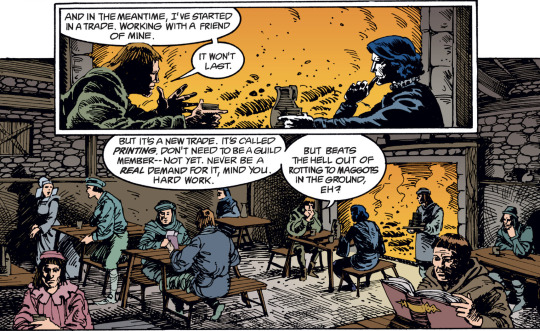
But it’s not until 1589 that we learn the name of this mysterious friend: William Caxton. (Mentioned by Hob as Billy Caxton)
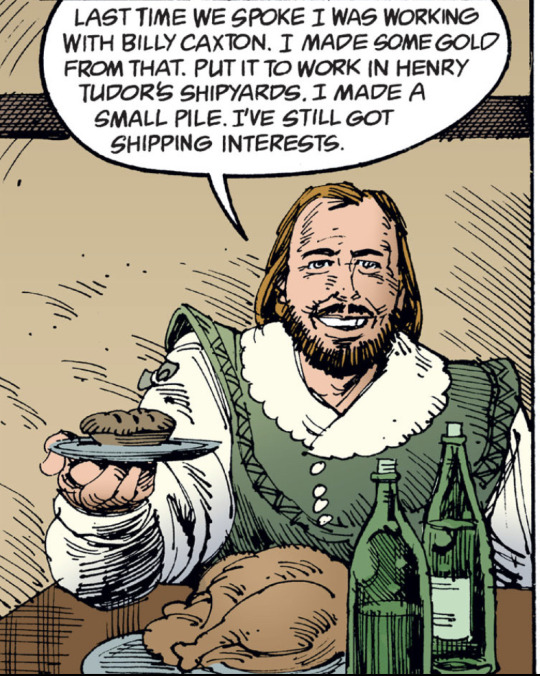
But who was William Caxton?
Caxton was an Englishman in the mid-1400s who started his career as a cloth maker and merchant. By the 1450s, he was living on the continent in Bruges and by 1465, he had turned to politics. With the War of the Roses underway in 1470, he had turned his attention to bringing printed books to the untapped market in England.
Printing was a new industry in the mid-1400s in Europe. (As opposed to the printing traditions of Asia.) Gutenberg had used his jewelry-making expertise to cast individual letters for printing around 1440, and developed a printing press that revolutionized books, publishing and illustration in Western Europe. Caxton likely traveled to Germany and saw a press in action around 20-30 yrs later before buying his own and setting up shop on the continent. Demand for works in English was low on the continent, so he soon moved his shop back to London.
What Caxton did was revolutionary for the time. No one was printing books in English. Even in England, scholars preferred Latin and French, considering them more beautiful and more expressive. Caxton not only brought a whole new trade/industry back to England…he also played an important part in our linguistic history. By translating works into vernacular English—specifically his London dialect—he was saying that English literature traditions were just as worthy as Latin or French for scholars and the masses. His work helped to standardize spellings at a time of great linguistic change. And his dialect that he was using became more widespread through his publishing. Plus, through his poor translation, English adopted a number of loan words.
The first book he printed once back in England? None other than Chaucer’s Canterbury Tales. He later published a second edition containing woodcut illustrations. He mostly published works he thought would be profitable with the gentry and then expanded his market by publishing works of popular fiction. His translation of La Morte D’Arthur helped popularize Arthurian legend.
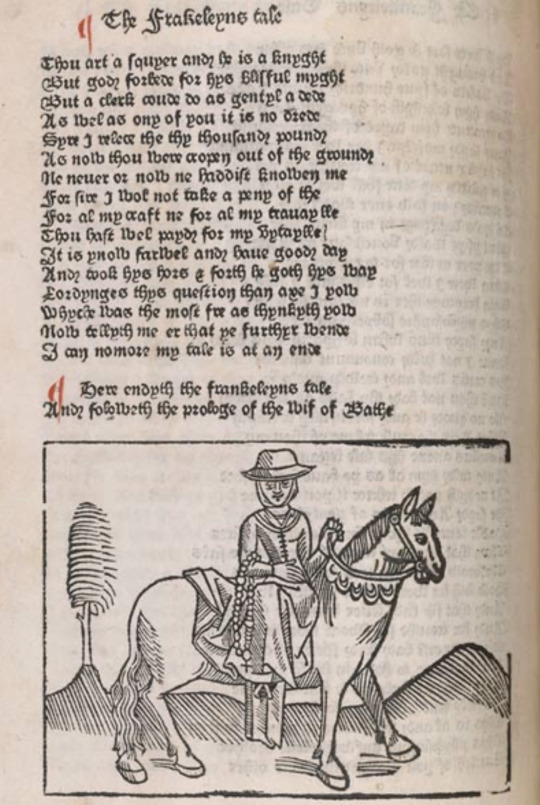
What did a 15th century print shop look like?
I imagine that when Caxton started out, he might have had to wear many hats. In this woodcut from 1568, two men are setting type into forms in the background while one person inks the form on press and the other pulls the print. Not pictured are separate jobs for folks to carve illustrations like the above out of wood (or use other printing making methods like intaglio, etc) and to bind the books.

Pulling a print could be manually hard work. Once the form is inked and the paper put into place behind a frisket, the whole apparatus is rolled under the platen on the right. Pulling the big level attached to the screw above the platen would apply even weight to the inked form, leaving an impression on the paper. Then, the apparatus would be rolled back out, the paper removed and the process started again. Once all the pages were printed, they would have been bound by bookbinders.
By the 1600s, the print shop could have had multiple presses with even more staff as shown in this engraving. Guilds would have been set up with proper channels for learning the craft. Plus, a whole merchant system was in place to sell all those books, pamphlets and prints.
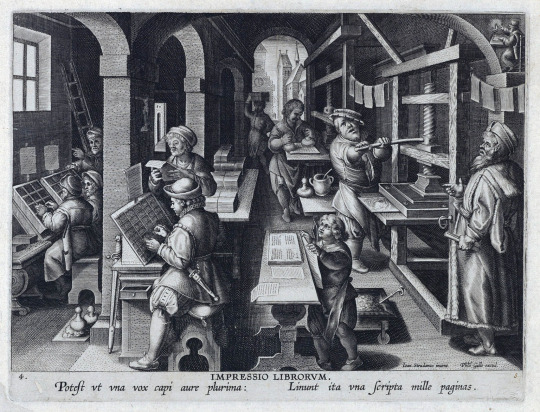
You can see a press like this in action in this video:
youtube
How does this tie into Men of Good Fortune?
Men of Good Fortune is as much a history of England overview as it is a history of English literature/language. By spacing his references out, Gaiman is able to allude to its evolution concisely for the purposes of his story and the limited real estate of his panels.
So here are Gaiman’s key references by date:
In 1389, we see Chaucer out for a drink with a friend in the midst of writing The Canterbury Tales.

In 1489, Hob is working with Caxton to set up his publishing business. Who would then go on to print several editions of Chaucer’s works.
In 1589, Hob refers back to Caxton by name, and we meet Shakespeare.
In 1689, no literature references
In 1789, Hob refers back to Shakespeare’s King Lear having a happy ending and asks after the nature of Morpheus’ deal with him.
In 1889, no literature references
In 1989, up to your imagination!
Hob and printing
For Hob specifically, his involvement could have meant many things. He could have become a typesetter and learned his letters. He could have been pure muscle pulling prints. He could have bound the books or carved the illustrations. And he could have branched out into being a merchant by selling said books. Or…all of the above.
As I’ve been writing this over the past week, @teejaystumbles just posted a printer!hob illustration. Was super excited to see it! Anyways, I’m hoping that this context was interesting for folks and I can’t wait to see if anyone writes/draws more printer!hob, because I can’t wait to read/see it!
#history of printing#hob gadling#William Caxton#printer!hob#sandman comic spoilers#Hob Gadling x Billy Caxton getting inky#sandman meta#mine
29 notes
·
View notes
Text
Gifting Stationery. Gifting Keepsakes: About Premium Handmade Diaries for Corporates

Handmade diaries are exquisitely handmade journals that are made with love and care by knowledgeable craftspeople or lovers of art. These diaries are often created utilizing high-quality materials and conventional bookbinding procedures, yielding one-of-a-kind, customized items.
For your corporate present requirements, consider the exquisite appeal of handmade diaries for corporates in a world where unique and heartfelt gestures stand out. These distinctive works of art provide a pleasant fusion of artistic designs, quality, and personalization, making them an excellent option for forging enduring relationships with customers, staff, and partners.
Here are some significant characteristics of handwritten diaries:
Design: Since handmade journals are produced by lone craftspeople or small-scale manufacturers, they can have distinctive and imaginative designs. There are many different styles available, ranging from modern and artistic to rustic and old. Each handmade journal has some aspects that varies slightly from the other, thus making it stand out compared to notebooks manufactured in bulk.
Customization: A lot of suppliers of handmade diaries provide you the opportunity to include personalized elements like your name or initials as well as your choice of cover design and paper type. These handmade diaries are therefore ideal as presents or for personal usage.
High-Quality Materials: Fine Kraft paper, artist paper, fabric, and numerous ornamental elements are frequently used by artisans to make handmade diaries. The journal is made with care to detail, making it both aesthetically pleasing and long-lasting.
Sustainability: To appeal to environmentally sensitive customers, some producers concentrate on using sustainable and eco-friendly materials in the production of their handmade diaries.
Artistic Touch: Handmade diaries frequently have creative touches, such as hand-painted covers, designer prints, hand-stitched bindings, and decorative components that give them a special, artistic flair.
Journals and Planners: Handmade diaries can be used as daily planners, trip journals, personal journals, or sketchbooks, among other things. To fit your demands, a variety of layouts and formats are available.
Local Craftsmanship: Buying a handmade diary frequently helps local artists and craftspeople, supporting the growth of small businesses and traditional craft techniques. Thus shopping locally is a great practice for a nation.
Price Range: The cost of handmade diaries can vary, with some being more reasonably priced and others being more expensive. The price is influenced by the materials used, the degree of personalization, and the quality of craftsmanship.
You can search local craft fairs, artisan markets, or online marketplaces where independent artisans and crafters sell their wares for handmade diaries. Considering that every diary is different, keep in mind that to receive exactly what you want, you might need to check on stock levels or place special orders.
Think about enhancing your corporate gifting plan with personalized diaries. These one-of-a-kind, adaptable, and environmentally friendly sculptures provide a distinctive way to show your gratitude and establish enduring connections. By selecting handmade diaries, you're not just giving someone a journal; you're giving them an experience and a physical example of your business's dedication to quality, innovation, and ethics.
Each diary is a masterpiece, showcasing the craftsmanship of skilled artisans. Add your company logo, a personalized message, or the recipient's name for a personal touch.
Looking for distinctive and memorable corporate gifts? Explore Boxyfont's exclusive collection of Handmade Diaries for corporates, meticulously crafted by skilled artisans. These unique diaries are printed with hand sketched designs that are inspired by the vintage novels that we love to read and are best suited for your clients, partners and employees. Set a great example by shopping local!
Visit: https://boxyfont.com/collections/the-kraftbook
#Handmade Diaries For Corporates#Handmade Diaries#Handmade Diaries For Gifting#Unique Kraft Notebooks#Kraft Paper Diaries
0 notes
Note
Admin, can you tell us your headcanon about what Ruki smells like?
Mukami Ruki: Scent Headcanons
♥ Sensual and aquatic, Ruki’s natural scent is quite subtle, akin to the smell of a gentle rainfall or a faint ocean’s breeze. Perhaps even a cool, rejuvenating lake swim in the Alps. He smells like the books he enjoys reading so much, both new and old alike, though it’s barely discernible in the hems of his sleeves and from the quiet quarters of his personal study where he spends so much of his time.
♥ Old books tend to have a sweet vanilla scent with notes of almond, which is caused from the chemical breakdown of the paper itself. On the other hand, new books have that crisp, inky smell to them, as well as the adhesives used in the process of bookbinding when they are manufactured. The ink smell can also be attributed to his fountain pens. In essence, it smells like pure intellect blew you a kiss.
♥ As a big fan of fountain pens, Ruki most likely shopped for his timeless and luxurious writing instruments at shops such as Montblanc, a company specializing in European craftsmanship founded in 1906. At first, they started off only manufacturing fountain pens, but then they branched out to other products such as cologne.
♥ One day when Ruki needed to buy a replacement, one of the staff members recommended a sample of their cologne. Curiosity compelled him to not only purchase their luxury pens, but also a whole bottle of the sample he tried on. It complemented his natural scent immaculately, emanating a strikingly masculine aroma.
♥ Ruki never sprays cologne directly on the skin, as his undead qualities wouldn’t allow use of its full potential. He enjoys applying it to the chest, shoulders, and general pulse points.
♥ His favorite scent from the Montblanc brand is Legend Spirit. Quite like its namesake, the aroma is legendary and occasionally attracts compliments from those he walks past in the bookstore, the shopping district, and at school. Very clean, refreshing, and loaded with a long-lasting citrus and aquatic aroma. It is neither offensive nor overpowering, yet its prominently seductive scent is one of a kind.
♥ This cologne in particular is perfect year-round, although he will only wear it outdoors as citrus easily sticks to food. As someone who always cooks for his family, wearing this formula would be disastrous to say the least. However, before heading outside, he sprays it in moderation onto his clothes.
♥ With wooded and fresh, spicy undertones, the top notes consist of grapefruit, bergamot, and pink pepper, giving it a dark and rosy fragrance and harmonizes well with his natural scent that screams captivating and passionate.
♥ After the top notes dissipate, the heart notes of the cologne really begin to shine through. Lavender, black cardamom, and mountain spring water notes all harmonize to create an independent, determined, and ruthless air to the head of the Mukami household, as expected of the brains of the family.
♥ At the crux of the fragrance are base notes of white musk, both cashmere and white woods, and oakmoss, all of which maintain an effortless elegance and charisma as if Ruki wasn’t already charming on his own. It lasts the whole day and causes heads to turn his direction when he passes through.
♥ Refreshing yet murky, he commands a somewhat biting impression from first whiff alone, yet he possesses a passing floral tonality akin to a mossy cottage where one might enjoy reading on the veranda under a sky of scintillating stars.
♥ Other colognes he enjoys using are Montblanc’s Explorer for the spring and summer at daytime, and Chanel’s Antaeus for autumn and winter at night. The former is woody with amber undertones whereas the latter has more of a leather and earthy scent, more suited for the indoors. A mystifying blend of smoky vanilla and a hint of musk.
♥ For the indoors, he prefers rustic aromas with the most subtle floral, sometimes even herbal, heart notes of rose, thyme, basil, and an inkling of jasmine.
♥ In general, he enjoys colognes that embody attitudes of success and strength.
♥ Aside from sprays, when he showers he typically reserves it for nighttime and uses separate shampoos and conditioners that linger into the next day. Ruki doesn’t believe in the 2-in-1 combinations they sell as he finds doing so strips him of the usual shine and healthy look he gets when done separately.
♥ Since black coffee is one of his favorite beverages, he smells lightly caramelized at times, slightly roasted and even a bit nutty. If you are an avid coffee drinker, then a whiff of Ruki might revitalize you completely as you have associated the scent with energy and caffeine coursing through you.
♥ Overall, Ruki smells dark, mysterious, with a subtle seductive composition, like a foreboding night’s wind under a sea of stars and ivory moonlight.
“You’re awfully close to your master right now. Who gave you permission to catch a whiff of me like this? Normally a light punishment would be in order for literally sticking your nose where it doesn’t belong, but today I’ll allow it. Come closer and I’ll engrave myself so deeply that everyone will smell my scent on you without fail. Know that you shall always be my possession, my property, and my prey.”

#diabolik lovers#ruki mukami#mukami ruki#ask#diabolik lovers headcanons#ruki mukami headcanons#mukami ruki headcanons
57 notes
·
View notes
Photo










Wood Engraving Wednesday
On New Year’s Eve, Ann Arbor wood engraver, letterpress printer, and founder of the Wood Engravers Network (WEN) Jim Horton sent us his new book on Commercial Wood Engraving in the 20th Century published in 2020 by The Legacy Press in Ann Arbor (what a wonderful way to start the New Year!). Horton has been a practicing wood engraver for over 40 years, and as he points out in his book, was drawn to the medium by his mentor David M. Sander (1923-1999) of the Sander Engraving Co. (1900-1971, Chicago), to whom this book is dedicated.
The book includes chapters on the history, tools, and processes of commercial wood engraving, and includes a preface by Judith Jaidinger, who Horton identifies as “the last commercial wood engraver.” The last two chapters offer a history of the Sander Engraving Company and a memoir of David Sander. The bulk of the book, however, consists of 114 luscious plates of product proofs from the Sander company, from which we offer a few examples here. We tend to be drawn to machine parts, and our favorites are the Threaded Screws! And just look at the beautiful rubbery sheen on those tires! Click on the images for greater detail. Wood engraving is effing awesome!
Other images shown here include photos of Horton’s studio. One of the tools Horton discusses is the ruling machine, which can make incredibly fine and detailed cuts. You can see a portion of one just off to the left in the photo of Horton’s engraving work space. When our department head Max visited Horton’s studio a few year’s ago, he says “there must have been about a dozen or so ruling machines in every corner of the studio; I’ve never seen so many in one place.” Horton has since donated a few of these machines for display and use at the Hamilton Wood Type & Printing Museum in Two Rivers, Wisconsin, where WEN maintains its headquarters.
Of this book, Cathy Baker, proprietor of The Legacy Press which publishes books on printing, paper, and bookbinding, writes: “Normally I don’t make personal comments, but I want to acknowledge that this is one of the most delightful books that I have published. Wood engraving is fascinating, and I only regret that I have not cut more blocks than I have. . . . I know you’ll find Jim’s story of David Sander and the Sander Engraving Co. as enjoyable and informative as I have.”
As an aside, The Legacy Press will soon be publishing Peter and Donna Thomas Bibliography, 1974-2020, which was compiled, written, and the photographs produced by the Thomases and the staff here at Special Collections, UW-Milwaukee. You can get a sneak peak at the bibliography by visiting our online exhibition on Peter and Donna Thomas.
View more posts with wood engravings!
#Wood Engraving Wednesday#wood engravings#wood engravers#Jim Horton#Commercial Wood Engraving in the 20th Century#The Legacy Press#David M. Sander#Sander Engraving Company#Judith Jaidinger#Cathy Baker
48 notes
·
View notes
Photo
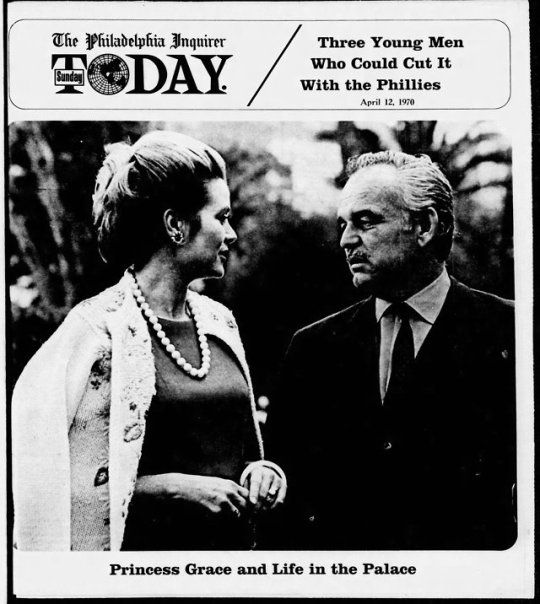
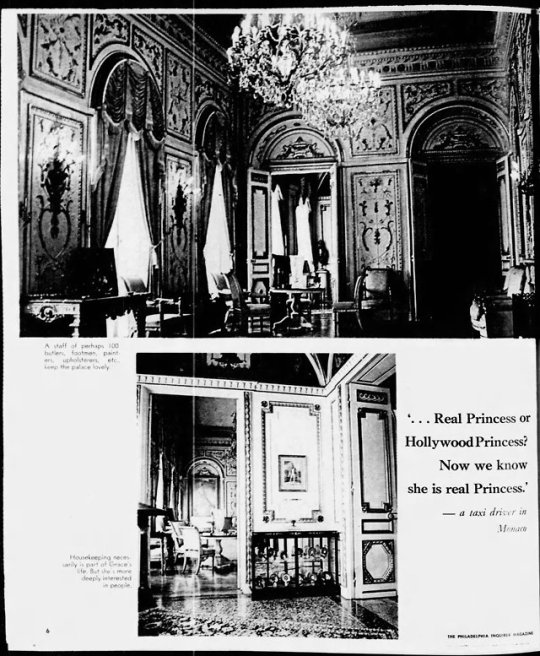
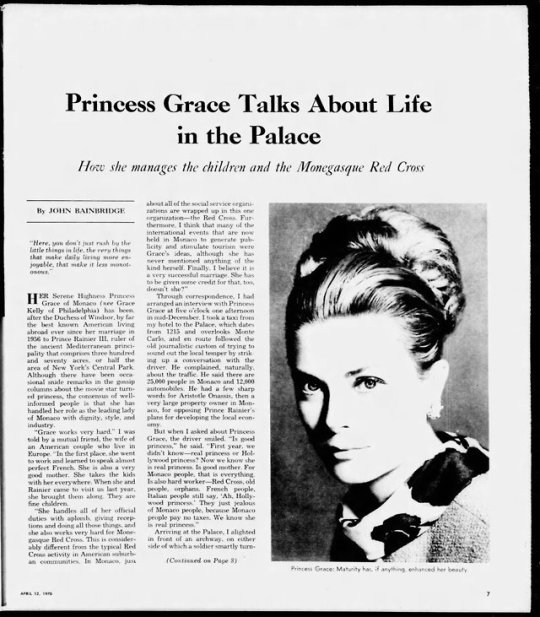
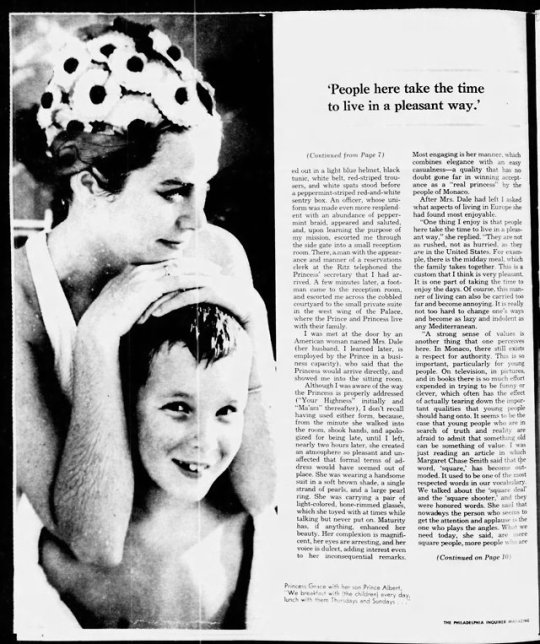
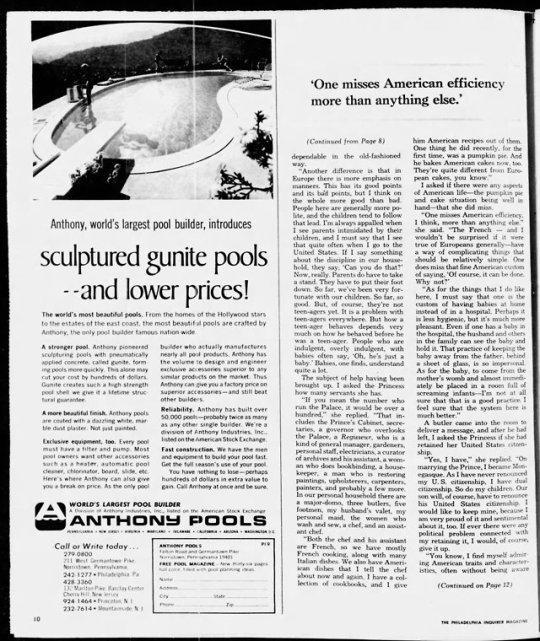
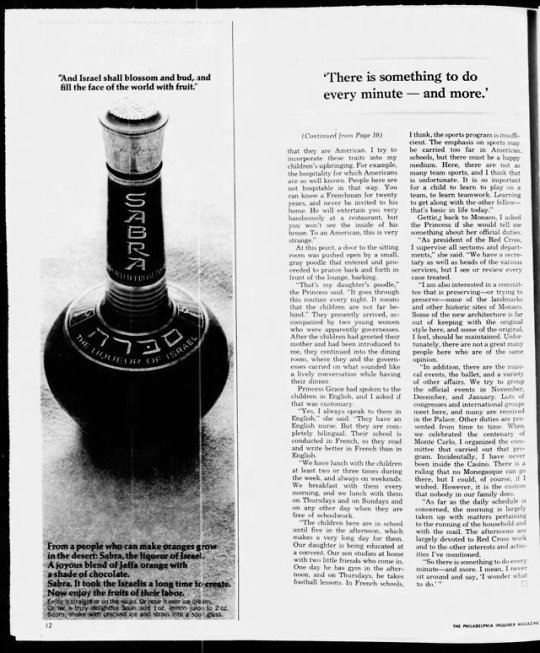
Sunday Today - the Inquirer Magazine (The Philadelphia Inquirer - April 12, 1970)
Princess Grace Talks About Life in the Palace
How she manages the children and the Monegasque Red Cross
By JOHN BAINBRIDGE
"Here, you don't just rush by the little things in life, the very things that make daily living more enjoyable, that make it less monotonous.''
HER Serene Highness Princess Grace of Monaco (nee Grace Kelly of Philadelphia) has been, after the Duchess of Windsor, by far the best known American living abroad ever since her marriage in 1956 to Prince Rainier III, ruler of the ancient Mediterranean principality that comprises three hundred and seventy acres, or half the area of New York's Central Park. Although there have been occasional snide remarks in the gossip columns about the movie star turned princess, the consensus of well-informed people is that she has handled her role as the leading lady of Monaco with dignity, style, and industry.
"Grace works very hard." I was told by a mutual friend, the wife of an American couple who live in Europe. "In the first place, she went to work and learned to speak almost perfect French. She is also a very good mother. She takes the kids with her everywhere. When she and Rainier came to visit us last year, she brought them along. They are fine children.
"She handles all of her official duties with aplomb, giving receptions and doing all those things, and she also works very hard for Monegasque Red Cross. This is considerably different from the typical Red Cross activity in American suburban communities. In Monaco, just about all of the social service organizations are wrapped up in this one organization the Red Cross. Furthermore, I think that many of the international events that are now held in Monaco to generate publicity and stimulate tourism were Grace's ideas, although she has never mentioned anything of the kind herself. Finally, I believe it is a very successful marriage. She has to be given some credit for that, too, doesn't she?"
Through correspondence, I had arranged an interview with Princess Grace at five o'clock one afternoon in mid-December. I took a taxi from my hotel to the Palace, which dates from 1215 and overlooks Monte Carlo, and en route followed the old journalistic custom of trying to sound out the local temper by striking up a conversation with the driver. He complained, naturally, about the traffic. He said there are 25,000 people in Monaco and 12,000 automobiles. He had a few sharp words for Aristotle Onassis, then a very large property owner in Monaco, for opposing Prince Rainier's plans for developing the local economy.
But when I asked about Princess Grace, the driver smiled. "Is good princess," he said. "First year, we didn't know - real princess or Hollywood princess? Now we know she is real princess. Is good mother. For Monaco people, that is everything. Is also hard worker Red Cross, old people, orphans. French people, Italian people still say, 'Ah, Hollywood princess.' They just jealous of Monaco people, because Monaco people pay no taxes. We know she is real princess."
Arriving at the Palace, I alighted in front of an archway, on either side of which a soldier smartly turned out in a light blue helmet, black tunic, white belt, red-striped trousers, and white spats stood before a peppermint-striped red-and-white sentry box. An officer, whose uniform was made even more resplendent with an abundance of peppermint braid, appeared and saluted, and, upon learning the purpose of my mission, escorted me through the side gate into a small reception room. There, a man with the appearance and manner of a reservations clerk at the Ritz telephoned the Princess' secretary that I had arrived. A few minutes later, a footman came to the reception room, and escorted me across the cobbled courtyard to the small private suite in the west wing of the Palace, where the Prince and Princess live with their family.
I was met at the door by an American woman named Mrs. Dale (her husband, I learned later, is employed by the Prince in a business capacity), who said that the Princess would arrive directly, and showed me into the sitting room.
Although I was aware of the way the Princess is properly addressed ("Your Highness" initially and "Ma'am" thereafter), I don't recall having used either form, because, from the minute she walked into the room, shook hands, and apologized for being late, until I left, nearly two hours later, she created an atmosphere so pleasant and unaffected that formal terms of address would have seemed out of place. She was wearing a handsome suit in a soft brown shade, a single strand of pearls, and a large pearl ring. She was carrying a pair of light-colored, bone-rimmed glasses, which she toyed with at times while talking but never put on. Maturity has, if anything, enhanced her beauty. Her complexion is magnificent, her eyes are arresting, and her voice is dulcet, adding interest even to her inconsequential remarks. Most engaging is her manner, which combines elegance with an easy casualness - a quality that has no doubt gone far in winning acceptance as a "real princess" by the people of Monaco.
After Mrs. Dale had left I asked what aspects of living in Europe she had found most enjoyable.
"One thing I enjoy is that people here take the time to live in a pleasant way," she replied. "They are not as rushed, not as hurried, as they are in the United States. For example, there is the midday meal, which the family takes together. This is a custom that I think is very pleasant. It is one part of taking the time to enjoy the days. Of course, this manner of living can also be carried too far and become annoying. It is really not too hard to change one's ways and become as lazy and indolent as any Mediterranean.
"A strong sense of values is another thing that one perceives here. In Monaco, there still exists a respect for authority. This is so important, particularly for young people. On television, in pictures, and in books there is so much effort expended in trying to be funny or clever, which often has the effect of actually tearing down the important qualities that young people should hang onto. It seems to be the case that young people who are in search of truth and reality are afraid to admit that something old can be something of value. I was just reading an article in which Margaret Chase Smith said that the word, 'square,' has become outmoded. It used to be one of the most respected words in our vocabulary. We talked about the 'square deal' and the 'square shooter,' and they were honored words. She said that nowadays the person who seems to get the attention and applause is the one who plays the angles. What we need today, she said, are more square people, more people who are dependable in the old-fashioned way.
"Another difference is that in Europe there is more emphasis on manners. This has its good points and its bad points, but I think on the whole more good than bad. People here are generally more polite, and the children tend to follow that lead. I'm always appalled when I see parents intimidated by their children, and I must say that I see that quite often when I go to the United States. If I say something about the discipline in our household, they say, 'Can you do that?' Now, really. Parents do have to take a stand. They have to put their foot down. So far, we've been very fortunate with our children. So far, so good. But, of course, they're not teen-agers yet. It is a problem with teen-agers everywhere. But how a teen-ager behaves depends very much on how he behaved before he was a teen-ager. People who are indulgent, overly indulgent, with babies often say, 'Oh, he's just a baby.' Babies, one finds, understand quite a lot.
The subject of help having been brought up, I asked the Princess how many servants she has.
"If you mean the number who run the Palace, it would be over a hundred," she replied. "That includes the Prince's Cabinet, secretaries, a governor who overlooks the Palace, a Regisseur, who is a kind of general manager, gardeners, personal staff, electricians, a curator of archives and his assistant, a woman who does bookbinding, a housekeeper, a man who is restoring paintings, upholsterers, carpenters, painters, and probably a few more. In our personal household there are a major-domo, three butlers, five footmen, my husband's valet, my personal maid, the women who wash and sew, a chef, and an assistant chef.
"Both the chef and his assistant are French, so we have mostly French cooking, along with many Italian dishes. We also have American dishes that I tell the chef about now and again. I have a collection of cookbooks, and I give him American recipes out of them. One thing he did recently, for the first time, was a pumpkin pie. And he bakes American cakes now, too. They're quite different from European cakes, you know."
I asked if there were any aspects of American life - the pumpkin pie and cake situation being well in hand - that she did miss.
"One misses American efficiency, I think, more than anything else." she said. "The French - and i wouldn’t be surprised if it were true of Europeans generally - have a way of complicating things that should be relatively simple. One does miss that fine American custom of saying, 'Of course, it can be done. Why not?'
"As for the things that I do like here, I must say that one is the custom of having babies at home instead of in a hospital. Perhaps it is less hygienic, but it’s much more pleasant. Even if one has a baby in the hospital, the husband and others in the family can see the baby and hold it. That practice of keeping the baby away from the father, behind a sheet of glass, is so impersonal. As for the baby, to come from the mother's womb and almost immediately be placed in a room full of screaming infants - I'm not at all sure that that is a good practice. I feel sure that the system here is much better."
A butler came into the room to deliver a message, and after he had left, I asked the Princess if she had retained her United States citzenship.
"Yes, I have," she replied. "On marrying the Prince, I became Monegasque. As I have never renounced my U. S. citizenship, I have dual citizenship. So do my children. Our son will, of course, have to renounce his United States citizenship. I would like to keep mine, because I am very proud of it and sentimental about it, too. If ever there were any political problem connected with my retaining it, I would, of course, give it up.
"You know, I find myself admiring American traits and characteristics, often without being aware that they are American. I try to incorporate these traits into my children's upbringing. For example, the hospitality for which Americans are so well known. People here are not hospitable in that way. You can know a Frenchman for twenty years, and never be invited to his home. He will entertain you very handsomely at a restaurant, but you won't see the inside of his house. To an American, this is very strange."
At this point, a door to the sitting room was pushed open by a small, gray poodle that entered and proceeded to prance back and forth in front of the lounge, barking.
"That's my daughter's poodle," the Princess said. "It goes through this routine every night. It means that the children are not far behind." They presently arrived, accompanied by two young women who were apparently governesses. After the children had greeted their mother and had been introduced to me, they continued into the dining room, where they and the governesses carried on what sounded like a lively conversation while having their dinner.
Princess Grace had spoken to the children in English, and I asked if that was customary.
"Yes, I always speak to them in English," she said. "They have an English nurse. But they are completely bilingual. Their school is conducted in French, so they read and write better in French than in English.
"We have lunch with the children at least two or three times during the week, and always on weekends. We breakfast with them every morning, and we lunch with them on Thursdays and on Sundays and on any other day when they are free of schoolwork.
"The children here are in school until five in the afternoon, which makes a very long day for them. Our daughter is being educated at a convent. Our son studies at home with two little friends who come in. One day he has gym in the afternoon, and on Thursdays, he takes football lessons. In French schools, I think, the sports program is insufficient. The emphasis on sports may be carried too far in American schools, but there must be a happy medium. Here, there are not as many team sports, and I think that is unfortunate. It is so important for a child to learn to play on a team, to learn teamwork. Learning to get along with the other fellow - that's basic in life today."
Getting back to Monaco, I asked the Princess if she would tell me something about her official duties. "As president of the Red Cross, I supervise all sections and departments," she said. "We have a secretary as well as heads of the various services, but I see or review every case treated.
"I am also interested in a committee that is preserving or trying to preserve some of the landmarks and other historic sites of Monaco. Some of the new architecture is far out of keeping with the original style here, and some of the original, I feel, should be maintained. Unfortunately, there are not a great many people here who are of the same opinion.
"In addition, there are the musical events, the ballet, and a variety of other affairs. We try to group the official events in November, December, and January. Lots of congresses and international groups meet here, and many are received in the Palace. Other duties are presented from time to time. When we celebrated the centenary of Monte Carlo, I organized the committee that carried out that program. Incidentally, I have never been inside the Casino. There is a ruling that no Monegasque can go there, but I could, of course, if I wished. However, it is the custom that nobody in our family does.
"As far as the daily schedule is concerned, the morning is largely taken up with matters pertaining to the running of the household and with the mail. The afternoons are largely devoted to Red Cross work and to the other interests and activities I've mentioned.
"So there is something to do every minute - and more. I mean, I never sit around and say, 'I wonder what to do.'"
13 notes
·
View notes
Video
youtube
Today, 28 July 2018 , is the First Feast Day of Blessed Stanley Francis Rother (1935-1981) Martyr, Priest, Missionary. Blessed Stanley was born on 27 March 1935 in Okarche, Oklahoma. He was martyred by gunshot at approximately 2am on 28 July 1981 in his rectory in Santiago Atitlán, Sololá, Guatemala.

Stanley Francis Rother was one of 4 children of Franz Rother (8 August 1911 – 2 July 2000) and Gertrude Smith (23 May 1913 – 24 October 1987), who had a farm close to that town in Oklahoma; sister Betty Mae, who became Sister Marita and two brothers, Tom & Jim. Stanley was strong and adept at farm tasks. Then after completing his high school studies at the Holy Trinity school he declared his calling to the priesthood to his parents. His parents were pleased with their son’s decision though his father asked him: “Why didn’t you take Latin instead of working so hard as a Future Farmer of America?” To prepare for this, he was sent to the Saint John Seminary and then to Assumption Seminary in San Antonio in Texas. His talents gained working on the farm left him with other duties at the seminary and his studies suffered and he struggled with Latin. He served as a sacristan, groundskeeper, bookbinder, plumber and gardener. After almost six years the seminary staff advised him to withdraw.

After consultation with his local bishop Bishop Victor Reed he then attended Mount Saint Mary’s Seminary in Emmitsburg in Maryland from which he graduated in 1963. Bishop Reed ordained him to the priesthood on 25 May 1963. Rother then served as an associate pastor in various parishes around Oklahoma and in 1968 – at his own request – he was assigned to the mission of the archdiocese to the Tz’utujil people located in Santiago Atitlán in the rural highlands of southwest Guatemala.

So that he could be in closer touch with his congregation, he set out to work to learn Spanish and the Tz’utujil language which was an unwritten and indigenous language that the missionary Ramón Carlín once recorded. He served in Santiago Atitlán from 1968 until his death. Rother lived with a native family for a while to get a better grasp of practical conversation and worked with the locals to show them how to read and write. He supported a radio station located on the mission property which transmitted daily lessons in both language and mathematics. In 1973 he noted with pride in a letter: “I am now preaching in Tz’utuhil.” During that time, in addition to his pastoral duties he translated the New Testament into Tz’utujil and began the regular celebration of the Mass in Tz’utujil. In the late 1960s Rother founded in Panabaj a small hospital, dubbed as the “Hospitalito”, Father Carlín served as a collaborator in this project.



By 1975, Rother had become the de facto leader of the Oklahoma-sponsored mission effort in Guatemala as other religious and lay supporters rotated out of the program. He was a highly recognisable figure in the community, owing to his light complexion as well as his habit of smoking tobacco in a pipe. Since there was not a Tz’utujil name equivalent to “Stanley,” the people of Father Rother’s mission affectionately called him “Padre Apla’s,” translated as “Father Francis,” in reference to his middle name.
Rother put his farming skills to good use in Guatemala, on one occasion operating a bulldozer from 7:00 am to 4:30 pm to clear land on local farms, stopping just for Mass. His door was open to all people. There was one old man who appeared each day for lunch and others came for advice on personal or financial affairs. Some even turned up to have their teeth extracted. On one occasion he accompanied a boy to Guatemala City to be treated for lip cancer, from which the boy was eventually cured.
Within the last year of his life Rother saw the radio station smashed and its director murdered. His catechists and parishioners would disappear and later be found dead, with their bodies showing signs of having been beaten and tortured. In December 1980 he had addressed a letter to the faithful in Oklahoma and wrote about the violent situation: “This is one of the reasons I have for staying in the face of physical harm. The shepherd cannot run at the first sign of danger.”

At the beginning of 1981 he was warned that his name was on a death list (he was number eight on the list) and that he should leave Guatemala at once to remain alive. One parishioner warned him in January: “Father, you’re in extreme danger. You must get out immediately.” Rother was reluctant but he nonetheless returned to Oklahoma in January, though he later asked the archbishop for permission to return: “My people need me. I can’t stay away from them any longer.” Another reason for returning was that he wanted to celebrate Easter with them. His brother Tom said to him, upon hearing that Stanley wanted to return to Guatemala: “Why do you want to go back? They’re waiting on you and they’re gonna kill you.” Rother said: “Well, a shepherd cannot run from his flock.” “Pray for us that we may be a sign of the love of Christ for His people,” said Fr Stanley, “that our presence among them will fortify them to endure these sufferings in preparation for the coming of the Kingdom.” Rother went back to Santiago Atitlán in April and knew that he was being watched.
On the morning of 28 July just after midnight, gunmen broke into the rectory of his church and shot him twice in the head after a brief struggle. The killers forced the teenager Francisco Bocel (who was in the church at the time) to lead them to the bedroom of the “red-bearded Oklahoma-born missionary.” The men threatened to kill Bocel if he did not show them Rother and so Bocel led them downstairs and knocked on a door near the staircase saying: “Father. They are looking for you.” Rother opened the door and a struggle ensued as Bocel ran upstairs hearing Rother yell: “Kill me here!” One shot pierced his jaw and the fatal shot struck the left temple; there were bruises on both hands. His father Franz – upon hearing the news of his son’s death – rang his eldest daughter Marita in Kansas and told her: “They got him.” She hung up the phone and wept.
Father Rother was one of 10 priests murdered in Guatemala that year. His remains were flown back to Oklahoma and were buried in his hometown on 3 August 1981, in Holy Trinity Cemetery. At the request of his former Tz’utujil parishioners, his heart was removed and buried under the altar of the church where he had served.
Three men were arrested on charges of murder within weeks of Rother’s murder, another man and a women were sought for questioning at that stage as well. The three men arrested admitted to having entered the church in a robbery attempt and also admitted to having shot Rother dead when the priest attempted to stop them. Despite the confessions, many people familiar with the circumstances of the murder considered the three accused persons as innocent and the prosecutions to be a cover-up of paramilitary involvement in the murder. Convictions for all three men were later overturned by a Guatemalan appellate court, under pressure from U.S. authorities. No other suspects have been prosecuted for the murder.

On 1 December 2016 his Beatification received approval from Pope Francis after the Pope confirmed that Rother had been killed “in odium fidei” (in hatred of the faith). On 13 March, 2017 the date for his Beatification was announcedand was Beatified on 23 September 2017 at the Cox Convention Centre, with Cardinal Angelo Amato presiding over the Beatification – as the Prefect of the Congregation of the Causes of the Saints on the Holy Father’s behalf at a Mass attended by approximately 20,000 people.


youtube
48 notes
·
View notes
Text
SO, WHO WAS HELEN WICK?
thankfully for me, canon tells us nothing!
this means i can make up whatever i want with little to no repercussions (i know there are comics that might say more and no, i haven’t read them). so here’s who helen wick was on this blog. and a little bit of a relationship timeline. it’s gonna be a long one, folks, so strap in. get a drink or something.
(seriously, if you read this whole thing, thanks.)
let’s start from the end: helen wick died when she was 53 from hodgkin’s lymphoma, spending the last four months of her life in the hospital. it was a slow miserable decline, in which her husband spent the last eight to twelve months of her life generally taking care of her in something so genuinely long-term, self-sacrificing, and tender that it probably would have surprised most of his former co-workers to learn about it.
she was a travel writer who wrote for a few different magazines. she grew up as the only child of a lower class family in san diego, and got her master’s in english and minor in communications, interning her way to an actual career throughout graduate school. her and her family are estranged at best, mostly because they disagree with her choice of career and the fact that she’s never home for anything. helen is probably more okay with this than she ought to be. it’s an estranged relationship at best by the time her and john meet.
she liked dogs and she drank a lot of stouts. she was anxious, almost perennially so, but high-functioning about it, to the point where she poured her anxiety into being good at her job (asking questions! noticing things! definitely not on edge a lot!). there’s a reason john was very good at calming her down, mostly because you have to steal his car and kill his dog or like. burn down his house to get him to be genuinely mad at you. perkins tried to kill him and he wasn’t even that angry about it. he is, in context, a genuinely patient person, which is part of why him and helen worked well together.
they met in venice, both because of their jobs. helen was drinking in a bar and writing down some things, and john mostly ended up in that bar to avoid being pursued by some guys. they struck up a conversation while john was lowkey bleeding from around three wounds hidden by his suit, he learned about helen’s job, and she was like hey, you should read my column in vanity fair. and then he didn’t for about three months until he actually remembered to. he sent her an email, she remembered the weird american “management consultant” she had met in venice and written a paragraph about, and thus began the long period of john fucking lying about his job.
some people might say that helen didn’t know what john did. i disagree. there’s no way she didn’t know - look at the house he eventually bought them! where did the money come from? she found out mostly because an assassin showed up to kill john right when they had arranged to meet up at his place, so she walked in on her friend next to a dead body, and him pretty much begging her to fucking leave, to not call the cops, and to take a different route than usual home. she did, and in top form, john wick then attempted to ghost his future wife.
didn’t work out. she insisted. they talked it out. they were just friends for a long while, helen operating as john’s contact in the civilian world. helen was the one who actually got the relationship moving, and then they spent a few years dating while john slowly and internally worked on the best way to get out. the impossible task happened, and he did get out but not without sacrifice, and then they got to figure out how to actually do marriage. helen suggested a courthouse wedding, aka just get it over with, and john was the one who insisted on at least something small. even if it was just them, helen’s fellow staff on whatever magazine she was writing for, and like.... marcus. winston probably called to be like ‘yes, i know and i’ve known for a while, but i’m wishing you the best, jonathan’, and that was it.
so helen and john got married and moved near brooklyn. he got into bookbinding. she kept writing and traveling, all the way until she collapsed at that waterfront park when they were out together.
it was better than he deserved, for five short years, and then it was gone. the center could not hold. and when it fell apart, so did everything else.
#at some point i'm gonna have to write an actual Thing about this not just a headcanon post#( everything's got a price. ) - CANONS.#( i'm waiting for you. ) - HELEN.
3 notes
·
View notes
Text
What Factors to Consider For Book Binding Service

Some factors to consider when selecting a book binding service for custom bookbinding. These include experience, paper quality, and cost. However, there are also some factors to consider before you make your final decision. If you are a first-time customer, you can save money by doing your bookbinding. The following section will cover what to look for in a bookbinding service. Before choosing a bookbinding service, you should carefully consider the page count, bulk order, audience, and design project.
Experience
When looking for a book binding service, you should pay special attention to the experience of the person doing the work. While bookbinding requires a wide variety of skills, a professional bookbinder will be familiar with dozens of basic operations. The bookbinding process is complex, combining the knowledge of other trades with the skill of hand-crafting books. Experienced bookbinders know how to work with various materials and the ins and outs of assembling a finished book. The bookbinder will have essential hand tools to use on a book, as well as heavy equipment and specialized machinery.
The experience of the bookbinding worker will make a significant difference in the finished product. Experienced bookbinders will know how to work with equipment and effectively communicate with clients and staff. They will have the skills necessary to bind books properly and quickly and the technical knowledge to troubleshoot any mechanical issues or delays. This will help them complete the job on time and of high quality.
Paper quality
When hiring a book binding service, you should know paper quality. Paper comes in different types and weights. There are matte and glossy papers. The latter is more expensive and will not yellow as quickly. White wove bound paper is the best option for blank books, while ledger paper and typewriter paper are better options for end sheets. Choose between domestic and imported paper based on the color and texture of the binding.
Art Bookbinders of America is a custom binding firm based in Chicago. They offer both digital and print services. Visit their website at www.abofa.com or call (312-226-4100).
0 notes
Text
starch producing companies in nigeria

Ifgreen Foods an Agro Processing Company that produces Fortified food for Healthy living at affordable prices within your reach in Nigeria. To be one of the foremost indigenous brands in Nigeria and a market leader in the industrialization of cassava in sub-Saharan Africa.
The factory is designed to operate continuously, three shifts per 24 hours, for 300 days per year. The total output capacity is 20mt tons per day or 6,000tons per year of High-Quality Cassava Starch (HQCS)
The plant being designed for our factory is based on well tried and tested modern technology.
The manpower required to run the factory for both skilled and unskilled labour is about 80 persons.
Our plant is judiciously operated with the technical oversight of professionals from the equipment manufacturers and IFGREEN staff.
With a team of experienced and versatile professionals and consultants in the agricultural industry, IFGREEN Industries & Investment Ltd was incorporated by the Corporate Affairs Commission to carry on the business of farm development, agricultural production, processing and marketing. The Company´s primary focus in her early years of operations is to engage in commercial farming and industrial scale processing of cassava into High Quality Food Grade Cassava Starch (HQCS) for manufacture of industrial and consumer goods. To visualize and to further emphasize our strategic outlook, IFGREEN is guided by an inspiring mission statement - "Engaging total agronomic management practice for best yield and benchmarking against global standards in operations and service delivery". This tagline expresses our ultimate promise to our stakeholders in a concise and compelling way. One of the cardinal objectives of the company is to open up new frontiers in the cassava industry through an aggressive focus on both mechanization farming approach and modern industrial-scale processing technology. We are modelling world-class practices in creating a production value chain for farm produce using innovative processes. We understand that our key success story will depend a lot on the strategies deployed to ensure constant supply of raw material from the first day the factory will commence operations. However, our serious and dedicated approach in gradual development of our nucleus farm will not only serve as a model farm but also for multiplication of improved stems to support our out grower scheme. We would also support small holder with tractorization, provision of inputs, organize training, we identify reliable farmers on the scheme and link them to banks in order to access funds faster to enhance their productivity.
Our products are grown according it’s to the organic food principles, and is 100% safe for you to cook and eat.
What makes our products even more special is that we plant and process every product with best standard practices and ensure quality assurance prior to shipping the orders, so that our customers get the best experience only!
IFgreen Industries and Investment Limited has a diverse pool of top notch management supplemented by a highly competent, diligent and driven work force. We have leading commercial scale cassava farmers who are core part of our team.
The proprietor possesses a strong business and leadership record across board. He is a dynamic entrepreneur with deep sector expertise and a passion for the F.M.C.G sector.
He has been successful in managing and running several organizations within the African business landscape including a shipping & logistics servicing company among others and has the potential to provide leadership in the agribusiness sector.
Our team is made up of an experienced farm manager and operation manager and also engages the services of consultants to assist in the operations. Our team also comprises of a plant manufacturer to manage the plant for 24months from inception.
IITA supervision is a major boost to our team efficiency. Working with IDH has helped sharpen the investment strategies of the entire project.
High-Quality Cassava Starch (HQCS): Cassava Starch is an important domestic and industrial raw material used in the manufacturing of various products including food, adhesives, thickening agents, paper and pharmaceuticals.
It has many remarkable characteristics including high paste viscosity, high paste clarity, and high freeze-thaw stability which are advantages to many industries. The Nigerian demand for starch is estimated at 269,000 tonnes per year but current supply is at 20,000 tonnes.
Starch uses as food also included in the preparation of bread, macaroni, custard, sauce, snacks and Ogi. The industrial uses include application in textiles, bookbinding, glue making paperboard, batteries, and cosmetics, paint and soap making.
Textile companies, in weaving, spinning, dye works, paperboards, dressing paints, leather adhesives, paste stamps and carpets, also use starch. It can also be used in artificial honey making, fruit juices, sweets, beer, canned fruit, and confectionaries and in pharmaceutical industries
To ensure freshness of cassava root supplied to the factory for processing, the raw materials will be sourced internally and within 50km-100km radius to the factory. The raw material are transported to the factory and processed within 24hours, this accounts for the quality of our products.
Contact Us
Call us at 09083288888, 09083188888
Email Us at [email protected] or [email protected]
Address
Along Epe – Itokin Express Road
Oke-Osho Village,
Ikosi/Ejirin L.C.D.A,
Near Epe Town, Epe Local Govt. area
Lagos State. Website - https://ifgreenindustries.com/
#Agro Processing Company in nigeria#market leader in the industrialization of cassava#cassava flour processing
0 notes
Text
ArchiveCon Info
Registration
Registration for ArchiveCon is completely free, and done through Eventbookings. However, we will not be accepting registrations during the event itself, so make sure you sign up early! Registration will permanently close on June 21th, 2024, at 12:00 PM, PST. Remember, that's four hours before we start!
Unsure if you can make the convention itself, or know that you can't get time off? No worries! Feel free to register anyways - this will grant you access to the Discord and any recorded panels that you can watch in your own time.
Once you’ve registered, keep up-to-date on any new info by following our twitter (@archive_con) and tumblr (@archivecon). When we get closer to the final date, we will send out an email containing the convention schedule, as well as Discord invites, so the community can get hyped up beforehand!
Register here!
In terms of attending the con itself, we will be using three different platforms: Discord, Zoom, and Twitch.
Discord: This will be the main community hub: chat with fellow fans, receive announcements, have access to staff members, talk to individual Artist Alley contributors, play games, etc. Consider this the hallway and info booth of an in-person con! The Discord group will be open about a week prior to the official con date, in order to let loose all those pre-con jitters and to deal with any questions attendees might have about panels, tech support, etc. The Discord will also stay open for a few weeks after the convention ends.
Zoom: We will be hosting the majority of our panels and activities here! Zoom is free to use for attendees. Each video has a chat section alongside, so attendees can talk about the panel or activity, and, if the panelist allows it, ask questions at the end. All attendees will be automatically muted when they join. If you'd like to watch our panels live, we highly recommend you download Zoom before the convention starts. We will also be hosting a few practice sessions so attendees and panelists can get comfortable with the program.
Twitch: Similar to Zoom, this is another option for panelists to choose from, if they have their own channel. Attendees will be able to type chat alongside the video screen.
FAQ
What is ArchiveCon?
This is an adults-only, online-only, mini convention that was spurred on by our love of podcasts (mainly TMA, but all sorts of others as well!) and all the marginalia fandom has to offer - from fanfiction to fanart, podfic to bookbinding, to the minutiae of sound editing and stitching - anything you enjoy goes! We aim to foster the spirit of creativity, learning, and freedom of expression.
Like any convention, there’ll be panels, discussion groups, an artist alley, streaming, and games - there’s a little something for everyone!
ArchiveCon will have a strong The Magnus Archives/Protocol bent, but we encourage fans of other Rusty Quill productions, outside audio dramas, and fandom-goers in general to join in as well!
Is the convention adults-only?
Yes. You must be 18 or older to attend the convention. However, this does not mean that panels and other activities will all be NSFW - this adults-only rule is merely to give our panelists and attendees more freedom in whatever they wish to discuss.
Is it free?
It sure is! All you’ll need is time and access to Discord, Zoom, and/or Twitch.
What timezone will you be in? And what are the hours?
ArchiveCon is based in Pacific Standard Time, and will take place from June 21 - 23rd - from Friday starting at 4:00 PM, until we finish on Sunday at 6:00 PM. To accommodate our international attendees, we allow panels to be held at any time during convention hours, and most panels will be recorded for later viewing.
Is this associated with Rusty Quill?
Nope! ArchiveCon is simply a by fans, for fans endeavor - completely non-profit, entirely for fun!
Rusty Quill online content is distributed and licenced under a Creative Commons Attribution-NonCommercial-ShareAlike International Licence. Details can be found here: https://creativecommons.org/licenses/by-nc-sa/4.0/
Where can I find more information on panels, the artist alleys, etc?
Check out our website! It’s got all this info and more.
8 notes
·
View notes
Text
0 notes
Text
Extra Credit 1: Raw Craft with Anthony Bourdain – Arion Press
San Francisco has always been considered a printing town, even amidst all the technology produced by Silicon Valley. Anthony Bourdain visited Arion Press where he interviewed the founder and master typographer, Andrew Hoyem, along with members of his talented staff made up of typecasters, proofreaders, printers, and binders, all dedicated to the meticulous and age-old process of bookmaking. Arion Press has been in business for over 40 years and is one of the few facilities of its kind in the world today. Hoyem believes that print is not dead and will never go away despite all the talk about the decline of physical books.

The host was taken on a tour of the entire process, which began in the type foundry, where he was introduced to the typecasters (only 50 worldwide) who type on a punched-paper tape on a spool. Then the spool is taken to a 100-year-old caster that prepares the type for printing.
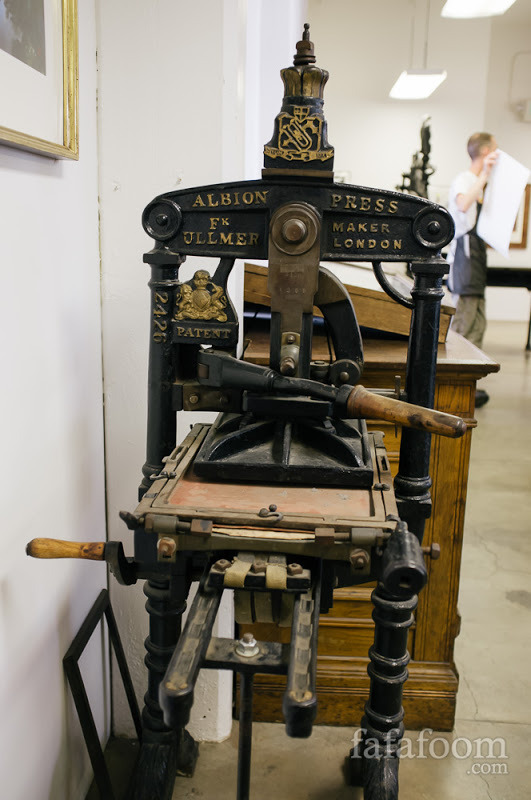

Next, the printers take over and painstakingly work the presses. The printed pages are proofread by reading each aloud and making corrections. Then, the pages are put together by the bookbinders who sew them, glue on the binding, and place the assembled book in a press. The result is a beautiful piece of work ready for all to enjoy.
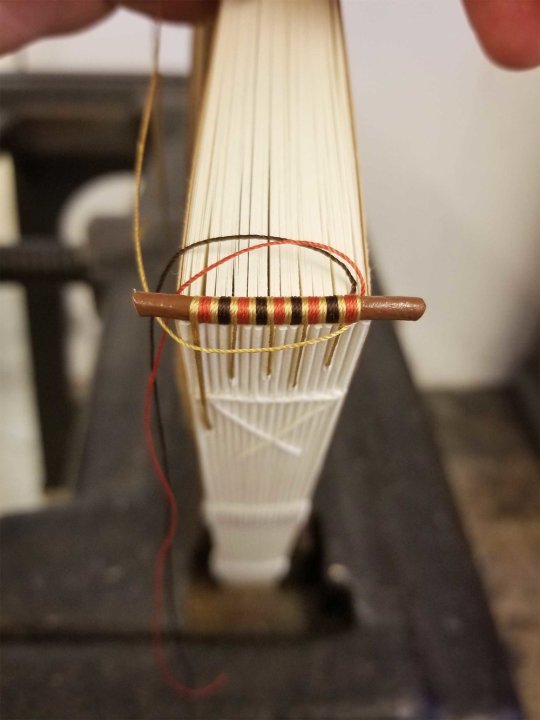
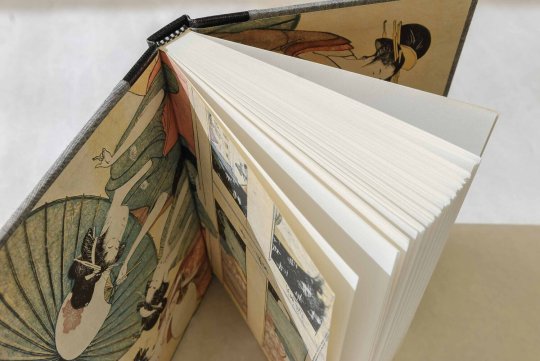

Most people are unaware of all the work that goes into creating this piece of art. They are oblivious to the fact that, after they are gone, another person could be reading the exact same book in the future, and so on. It will be something that will be passed down through many generations. Anthony Bourdain concludes that well-made books have histories and pasts similar to great recipes having high-quality utensils and knowledgeable chefs as he toasts the amazing craftsmen (and craftswomen) of Arion Press, a company that pairs great artists with great literature to create beautiful limited-editions by hand.
After watching this episode, it made me wonder if printed books have become an endangered media due to emergence of e-books. In today’s fast-paced, short-attention, immediate-gratification world, downloading reading material to your Kindle, iPad, or smart phone would be a convenience that no one could resist, right? I mean, we have seen the evolution from vinyl to 8-track to cassette to CD to MP3 and now to High-Resolution Audio. These days, it is all about hi-res audio becoming the rage with the sporadic nostalgic collector still purchasing the occasional record album. So, I was surprised to learn that this was not the case with books! According to the Association of American Publishers’ annual report 2019, of the $26 billion in revenue generated by books last year, $22.6 billion were physical books while only $2.04 billion were due to e-books. While digital media has disrupted other industries, such as news publishing and the music business, people still love to own physical books.
There are a few reasons why people still find physical books so appealing. Publishers like Arion Press still produce gorgeous works of arts with their painstaking bookmaking combined with beautiful covers.



People love to display what they have read and proudly decorate their homes with exquisite books that reveal who they are. Some are collectors similar to those who accumulate art or figurines.

Some genres do better in print than digital, such as nature, cookery, and children’s books while crime, romantic novels, and thrillers tend to attract the e-reader. When people are just looking for information, a digital format will suffice. However, when people want to escape, it is easier to form an emotional relationship or bond with a physical book than it would be with text on a cold screen. I was shocked to find that millennials, who are blamed for a multitude of things, appear to be popularizing print. According to Nielson, 63% of physical books sales in the U.K. were to people under the age of 44. In the U.S., 75% of people aged 18 – 29 claimed to have read a physical book in 2017, higher than the average of 67%.
As for the future of books, it still looks bright regardless of the format. “People always need knowledge and people always need stories…” says Jacks Thomas, director of The London Book Fair. As long as places like Arion Press continue to produce beautiful pieces of art, there will be no shortage of people who will enjoy them.
0 notes
Text
New story in Politics from Time: Ivanka Trump Defends Tweeting Goya Beans Photo as Government Watchdogs Call it Unethical
(WASHINGTON) — Ivanka Trump on Wednesday defended tweeting a photo of herself holding up a can of Goya beans to buck up a Hispanic-owned business that she says has been unfairly treated, arguing that she has “every right” to publicly express her support.
Government watchdogs countered that President Donald Trump’s daughter and senior adviser doesn’t have the right to violate ethics rules that bar government officials from using their public office to endorse specific products or groups.
These groups contend Ivanka Trump’s action also highlights broader concerns about how the president and those around him often blur the line between politics and governing. The White House would be responsible for disciplining Ivanka Trump for any ethics violation but chose not to in a similar case involving White House counselor Kellyanne Conway in 2017.
White House chief of staff Mark Meadows told reporters accompanying the president to Atlanta on Wednesday that he doubted Ivanka Trump would face any repercussions.
Read more: Fearing Internal Dissent Ahead of the Election, Trump Expands His War on Washington
Goya became the target of a consumer boycott after CEO Robert Unanue praised the president at a Hispanic event at the White House last Thursday.
Trump tweeted the next day about his “love” for Goya, and his daughter followed up late Tuesday by tweeting the photo of herself holding a can of Goya black beans with a caption that read, “If it’s Goya, it has to be good,” in English and Spanish.
Almost immediately, government watchdogs and social media commentators accused Ivanka Trump of violating ethics rules — an issue that was not addressed in a White House response statement that blamed the news media and the culture of boycotting certain views.
“Only the media and the cancel culture movement would criticize Ivanka for showing her personal support for a company that has been unfairly mocked, boycotted and ridiculed for supporting this administration — one that has consistently fought for and delivered for the Hispanic community,” White House spokesperson Carolina Hurley said in an emailed statement.
“Ivanka is proud of this strong, Hispanic-owned business with deep roots in the U.S. and has every right to express her personal support,” Hurley said.
Ivanka Trump sent the tweet from a personal Twitter account that does double duty chronicling her work on various White House initiatives.
Trump himself appeared to back up his daughter Wednesday by posting a photo on his Instagram account showing him in the Oval Office in front of various Goya products arrayed on his desk. As president, Trump is exempt from many of the rules that federal workers must follow.
View this post on Instagram
A post shared by President Donald J. Trump (@realdonaldtrump) on Jul 15, 2020 at 11:02am PDT
Walter Shaub, former director of the Office of Government Ethics, said on Twitter that the tweets and photos amounted to “an official campaign by the Trump administration to support Goya, making it all the more clear that Ivanka’s tweet was a violation of the misuse of position regulations.”
Shaub left government in 2017 after clashing with the Trump administration over ethics rules.
Citizens for Responsibility and Ethics in Washington said the rules are clear.
“The ethics rules for executive branch employees say that you can’t use your official position to promote a private business,” said Noah Bookbinder, executive director of CREW. “It’s pretty clear that the context in which this came out is that Goya had been supportive of the Trump administration and the Trump administration was being supportive of Goya.”
Craig Holman, the Capitol Hill lobbyist for Public Citizen, said the episode was reminiscent of a 2017 incident when, during a nationally broadcast cable TV interview, Conway urged Trump supporters to buy Ivanka Trump’s clothing and accessories after Nordstrom dropped the fashion line. The White House later said Conway had been “counseled” about her comments.
Holman argued that Ivanka Trump’s action was less of a mistake given the Conway incident.
“They decided to violate federal law thinking that it will benefit them politically,” he said. Trump is looking to improve his standing with Latino voters before November’s election. He won the votes of about 3 in 10 Latino voters in 2016.
Meadows defended Ivanka Trump. “I don’t know from my standpoint I see this as a huge promotion of Goya Foods as much as it is expressing appreciation for someone who is willing to show great political courage,” the White House chief of staff said.
The president often blurs the lines between politics and governing.
Trump used a speech Wednesday at a UPS facility in Atlanta on environmental permitting to rail against allowing mail-in voting for the November election and against Democratic rival Joe Biden. He also used a Tuesday news conference in the White House Rose Garden, where presidents traditionally have refrained from politics, to lash out at Biden.
Last year, Trump floated the idea of hosting a 2020 summit of world leaders at his private, for-profit golf club near Miami, but backed down after a bipartisan outcry over the conflict of interest.
Separately Wednesday, CREW filed a complaint with the Office of Special Counsel, an independent federal investigative and prosecutorial agency, against Meadows. The group alleges that Meadows violated the Hatch Act during recent television interviews in which he advocated for Trump and against Biden. The Hatch Act prohibits government officials from using their positions to influence political campaigns.
The Office of Special Counsel said it could not comment beyond acknowledging receipt of the complaint. The White House did not respond to a request for comment.
By Darlene Superville / AP on July 16, 2020 at 12:21PM
0 notes